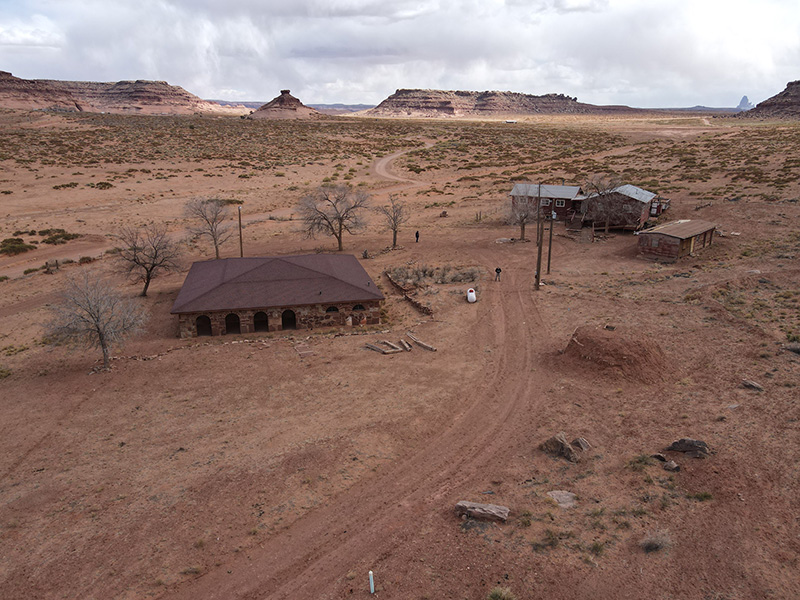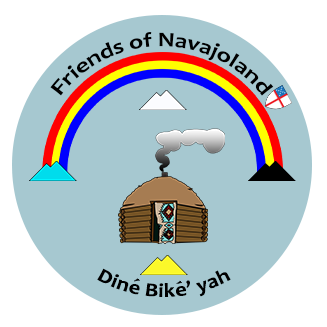
“On Navajo Time”
We’ve spent 20-plus summers here, at St Mary’s of the Moonlight. The small mission outpost of the Episcopal Church is located on a desert road between Monument Valley and the town of Oljato, Utah, population of 880, and an elevation of around 5,000 feet (depending on which rock you stand.) The church is a work of art: a square shape built from irregular slabs of native sand stone in shades of sepia to red-orange to a pinkish gray, with a sloping roof and wrap-around arched porches. The altar is from the same stone, and the ceiling has an octagonal structure, like a large Hogan—the Navajo’s traditional home—with the door facing east. The parish house remains, for all the loving labor of volunteers, a ramshackle place, too small for most groups of summer visitors, our present one a lively gang of 24. Yet, compared to people living in this area, our compound is luxury. We have electricity, water, indoor plumbing, a refrigerator and gas-stove, even a microwave…
George and I first learned about St. Mary’s during a visit from a friend who lives in Ohio. Bob had already traveled to the mission four times with a group from his church—Trinity Hamilton. He described his experiences with such enthusiasm that we decided to get involved. His parish and others worked on re-opening the place which had been closed about a decade after the death of Fr. Baxter Liebler in 1982. The legendary priest from Greenwich, CT. moved into the area forty years earlier. He first came on horseback, fell in love with the arid landscape and its people, and—except for brief visits home—never left again. He established three churches in Utah: St.Christopher’s in Bluff, St.John’s in Montezuma Creek, and St.Mary’s in Oljato, where he retired.
The life purpose of Fr. Liebler became to teach, learn from, and live among the Navajo people. We found out he’d baptized many of the elders in this valley, addressed their health needs, and taught them not only the Gospel (with the help of their own rituals and imagery) but also to read and write. In those days, the mission featured a clinic with a birthing center, a community well, and a small school house. Memories of the Indian Boarding Schools, a government sponsored system of coercion (often abuse) were still fresh in people’s minds. They feared the White Man’s methods of education, which had forced them to deny their culture. They trusted Fr. Liebler, who let his hair grow instead of cutting theirs, who learned their language and their ways. Because of him, they trust us…
Groups from at least six different churches made up an organization called “Friends of Navajoland”. Most of them came in the summer for a week, to live and work at St. Mary’s.
Over the past twenty years, they/we have done a variety of projects: built houses, additions, and porches, repaired roofs, performed various fix-up jobs, mounted cattle fences, taught summer classes at the local high school, put on creative Vacation Bible Schools and community suppers. Some of us have—with the help of Navajo friends—sheared sheep, planted corn and squash, baked traditional Fry-bread, and slapped mud on a Hogan. We’ve improved our living space by small increments: new plumbing, bunks and shelves, two large decks, numerous coats of paint, a second shower (outdoor no less!), a freezer, dishes, and cooking tools. Thanks to our generous friend Dottie from Sedona, the church roof was replaced when needed, and hymnals were printed in the Navajo language.
A few years ago, a traditional Hogan was built on the property by a local crafter: cedar posts stacked in a circular, womb-like design and covered with damp earth, leaving a skylight at the top. Inside it feels cool and has a deep-woods smell. The VBS teachers use the Hogan to share sacred stories—ours and theirs. Often these turn out to be quite similar stories. For example: the Israelites were sent into exile, weeping and praying by the Rivers of Babylon, until they were allowed to come home. The Navajos were forced on their Long Walk to Fort Sumner, where many of them perished. The survivors return to their native land and kiss the ground in gratitude. Painful, archetypal experiences that end with a sense of deliverance.
We’ve learned to work in blazing heat and cook at high altitudes, with a relentless desert wind blowing out the gas flames. We’ve learned to sweep red sand from every surface with fierce determination and to give up sweeping. We’ve learned the necessity of an ‘afternoon siesta’ and of star-gazing at night. Most important, we formed lasting friendships with people in the community. We’ve seen their kids grow, bought their jewelry and rugs, and gotten to know more about each other’s culture. They always ask: Are you coming back?
In the last ten years, George and I brought groups from our own parish here: Christ Church Westerly, RI. For a while, we had a strong “East Coast” presence, spear-headed by our friend Seth who in turn recruited our talented Christian Ed teachers, Wendy and Rebecca, and their children and friends. Seth also mobilized (through his brother John) some dedicated Lutherans from Wisconsin to join the team. They’ve worked with us for several years, and their leader, Pastor Mike, brought an enthusiasm that is hard to resist.
Most of the young people that came were a great help, especially when we provided Vacation Bible School. A few outsiders have a hard time adjusting to the “deprivation” of luxuries. One rationale for bringing our children is for them to experience how different the lives are of youngsters here. Our drivers pick up the Navajo kids from their homes on VBS mornings, and they usually take a mission teenager along. Their cars slither on bumpy sand-roads to stop at trailers, Hogan, and wooden huts surrounded by assorted household stuff, skinny goats, broken-down cars… Yet the children who pile into the vans have clean clothes and shiny faces, combed hair with barrettes or scarves. Some wear hand-made jewelry. They often bring—even carry—their younger siblings, for whom they are responsible while parents work. I never forget the comment one of our teenagers made after picking up three children from their family Hogan. “My room,” he said, shaking his head “is bigger than their entire house”.
He said it not with pity but with respect.
Often I’ve asked myself, what difference does it make that we come? There’s always the stark poverty. Unemployment, cancer and diabetes, drugs and gangs, school drop-out rates, and apathy don’t seem to change. Although the locals like coming to our church, there’s nobody yet geared to take it over and make it a self-supporting Navajo church. That was the goal of our friend Steven Plummer, the only ordained Navajo bishop who died of cancer in 2005. It was the vision as well of his successor, Bishop Marc MacDonald, who took over for him, followed a few years later by Bishop David Bailey. The goal is still far from becoming reality. Obstacles are not so much spiritual as practical: lack of leadership, funding, and organizational skills.
Something else I’ve learned here, harder to apply at home, is to live each day on life’s terms: the foibles of weather, a power outage, a flat tire, a sore back, a forgotten item at the store, a mangy dog or a herd of goats at the door… there’s a blessing in all once you accept the given. People do not hurry here; time arrangements are tentative. Our community suppers are advertised (via a red-lettered plastic cloth tied to the fence) for 6 p.m., but guests may show up any time between 5 and 8 p.m. It depends on their mode of transportation, ranging from van to open truck to ATV to horse or foot. There’s always enough food to go around: Sloppy Joes, hot dogs, chips, potato salad, corn pudding, watermelon. We do a short Evening Service together–the prayers feel tangible and powerful. Then we sit outside on our rickety metal chairs, chatting or in pleasant silence, kids and pets racing around us, until the last color drains from the mesa…
After our Christ Church Westerly group arrives back home each year, we meet to debrief our experiences. The question arose: What really is our mission in Navajoland? We go around the table with tentative formulations. We agreed that it’s not to “bring Jesus to the people” for he is already there. It’s to keep St Mary’s alive, some say. Or, to share each other’s traditions and stories, and allow the painful scars of history to heal. It’s to help in practical ways, to be loyal to the friends we made, honor their trust. To re-discover a sense of the sacred (God, Creator, Holy Spirit) in this humble desert place, learn to worship in new ways. All of that had a ring of truth. Once Wendy, our VBS leader that year, said: “I think we’re giving them hope!” I’d answered: “But hope in what?” I thought (but didn’t say) that neither The American Way of Life nor most imported versions of Christianity had done the Natives of this country any good. Perhaps Wendy read my mind. She added: “I mean, hope in who they are…because we care about that.” Now it made sense. The people we work with might appreciate their own gifts—the gifts of their culture—just a bit more because we do.
Seth reminded us that, out there, we get much more than we give. We receive hope as well. Hope that in due time—God’s time? Navajo time?—we’ll have learned enough, from each other and from our mistakes, that a bright new vision for St Mary’s will appear. In the meantime, our “mission” is to continue walking where the Spirit has led us so far– in short, to be faithful. And, as our Navajo friends have taught us, to practice “Walking in Beauty”.
